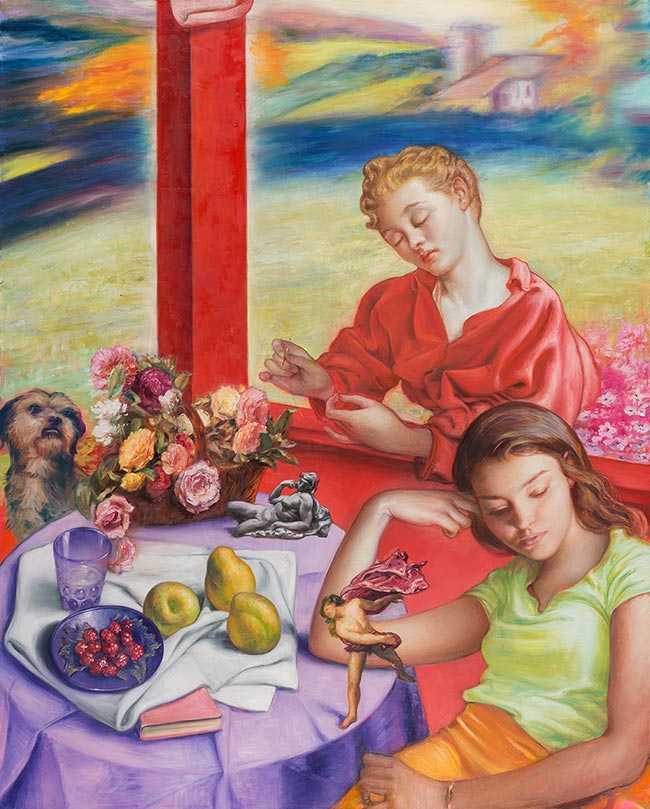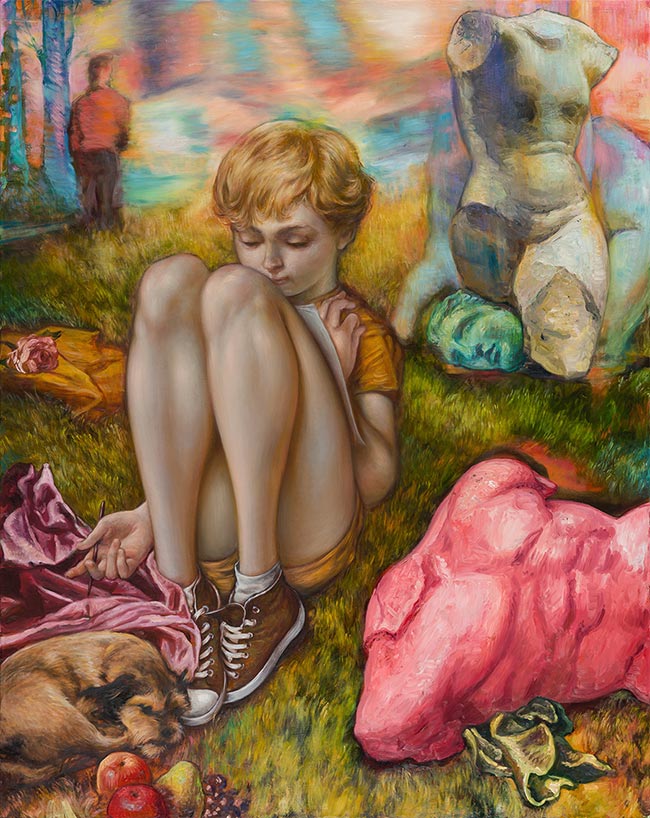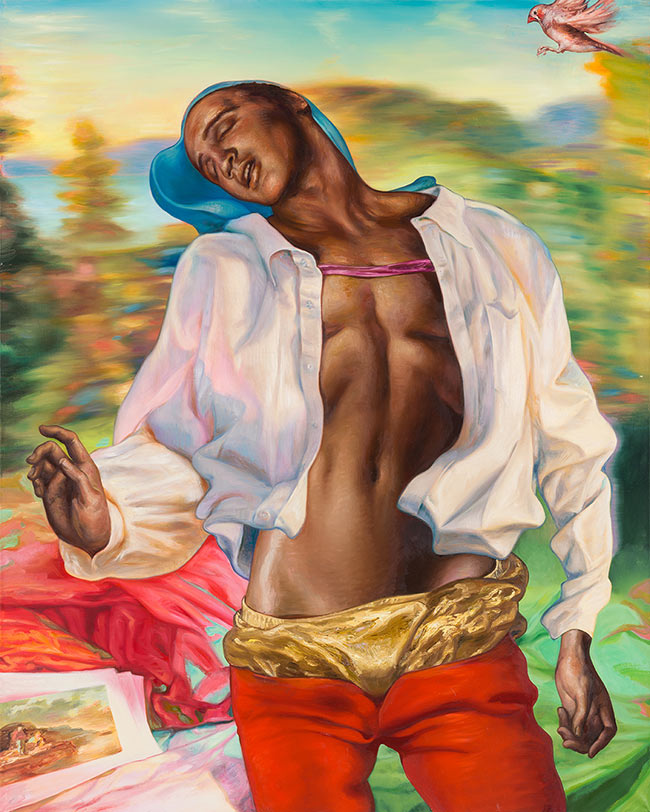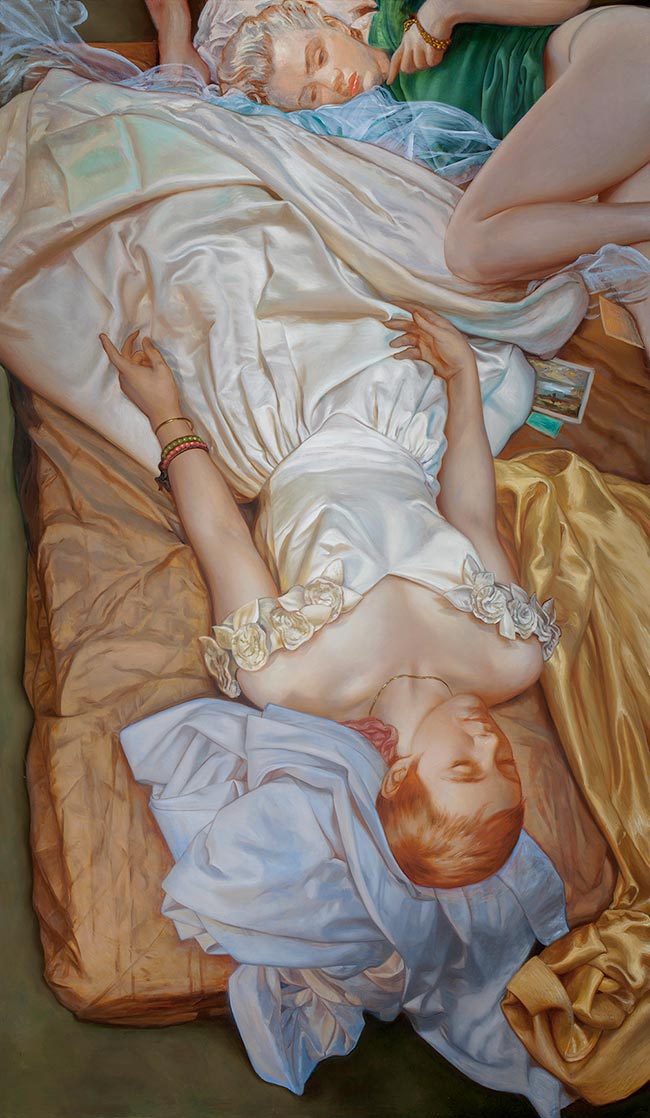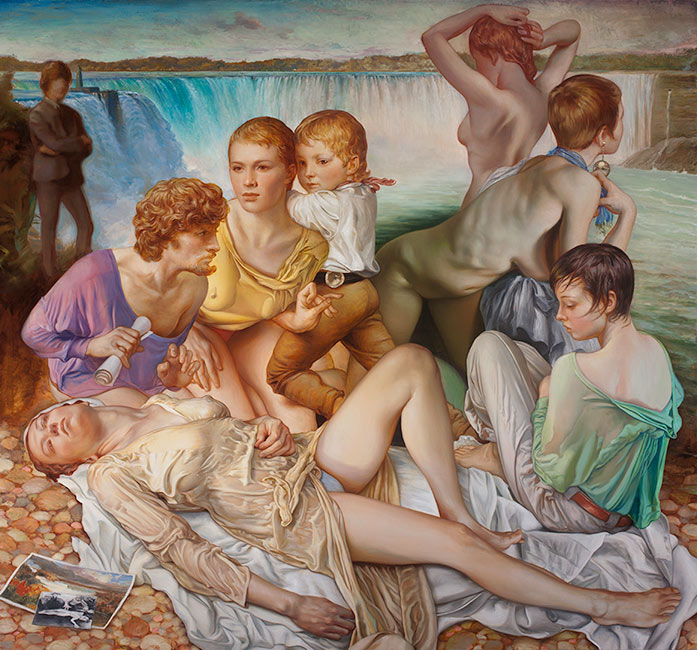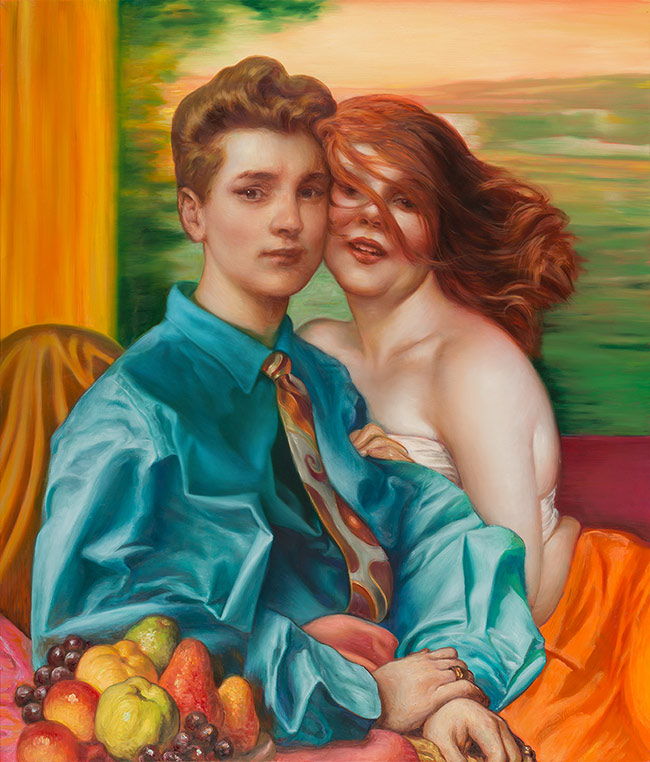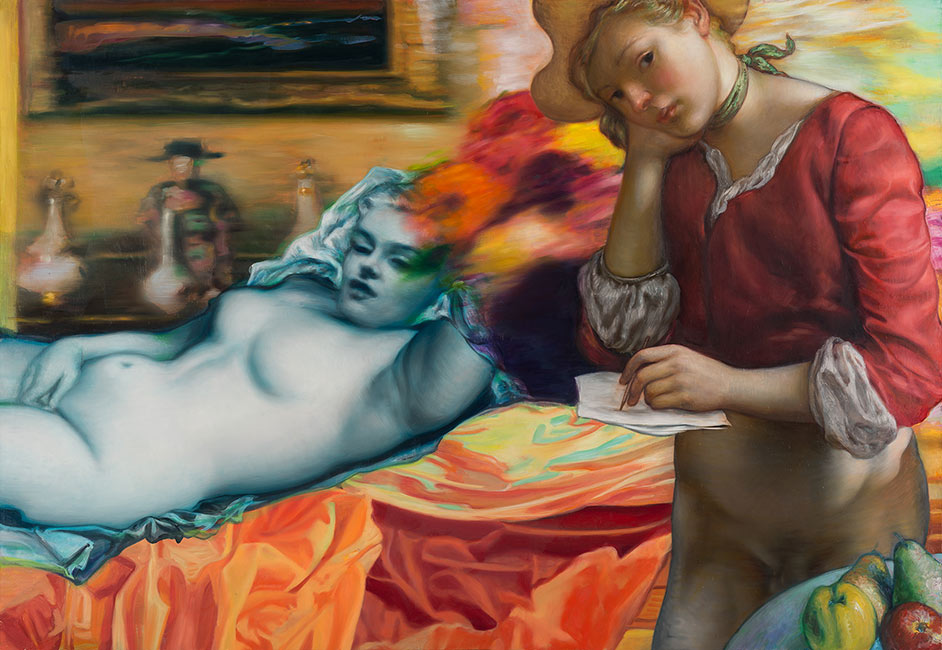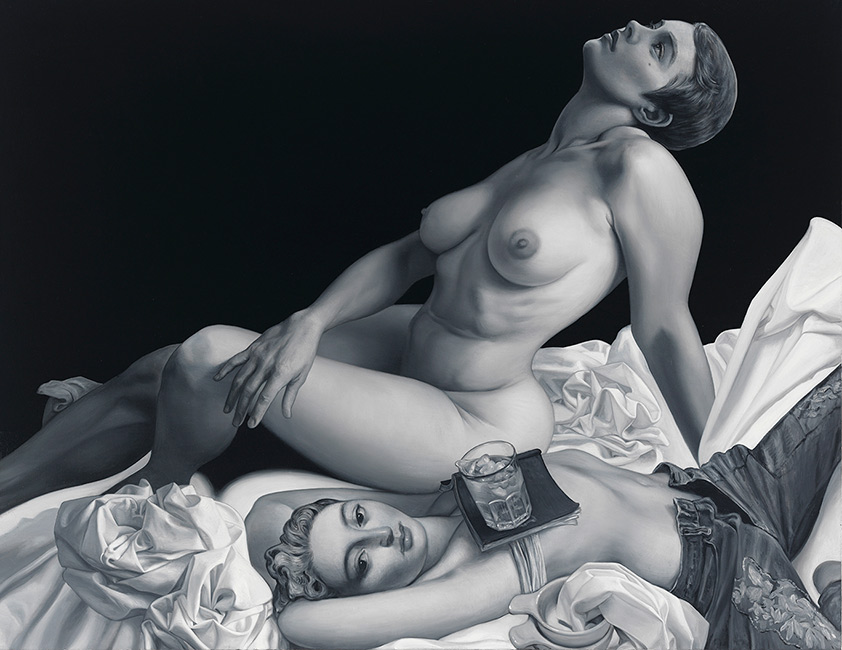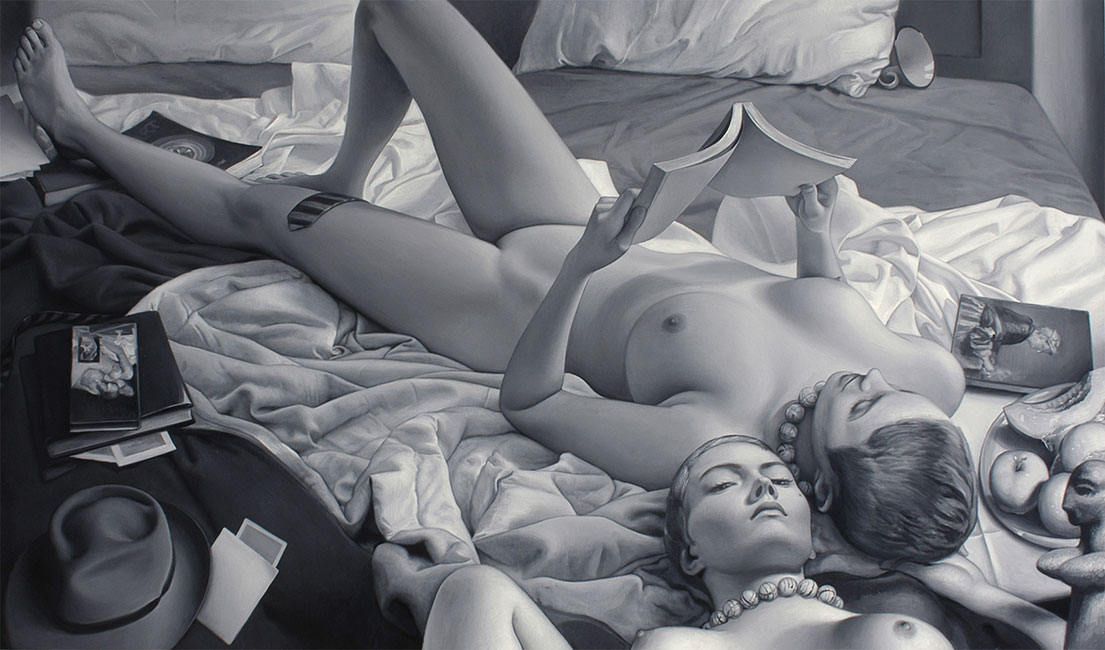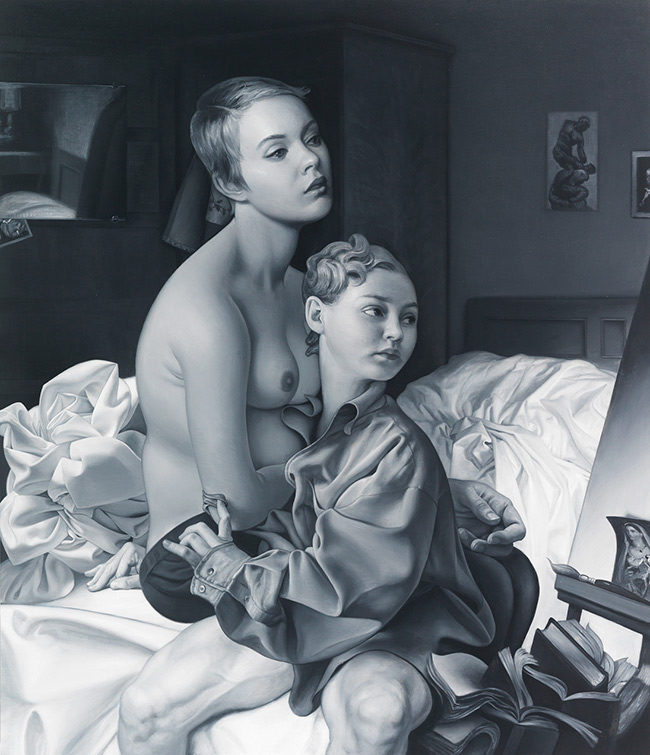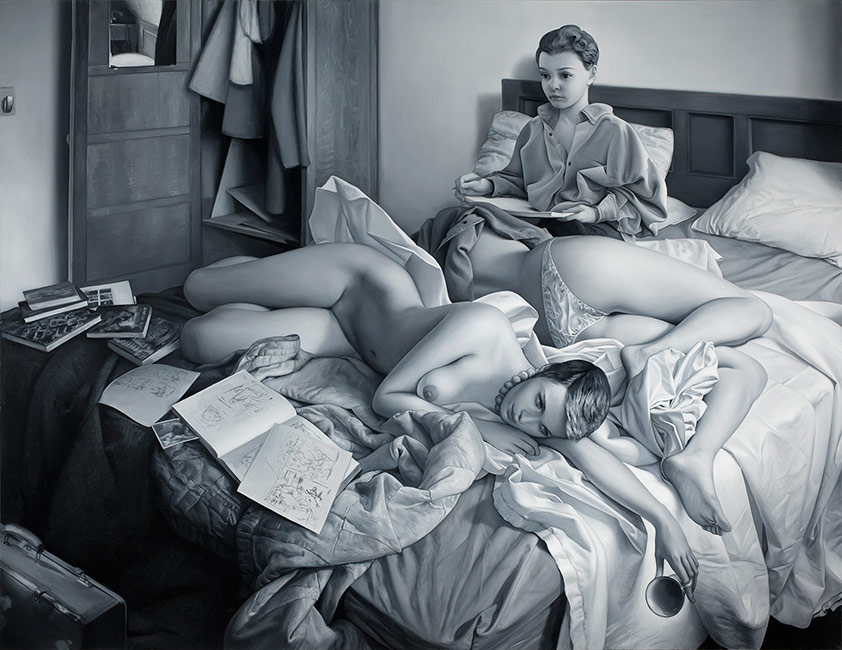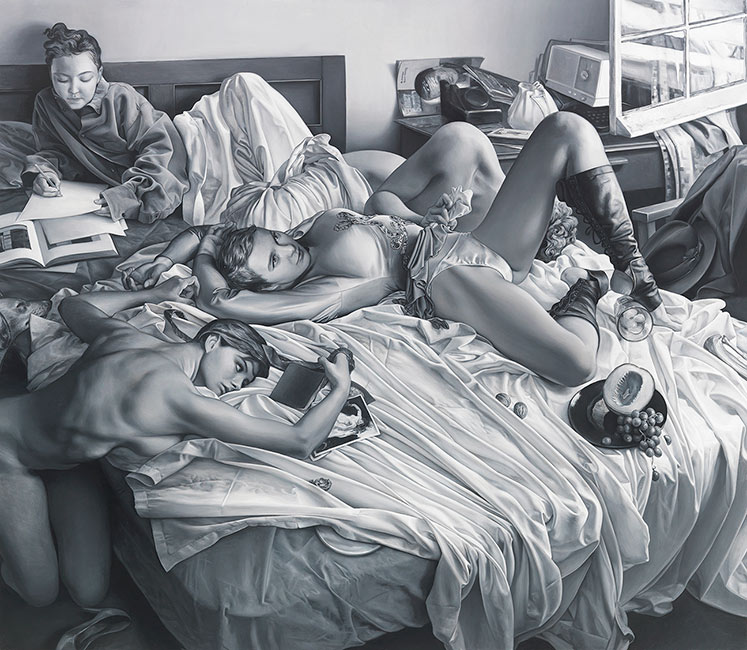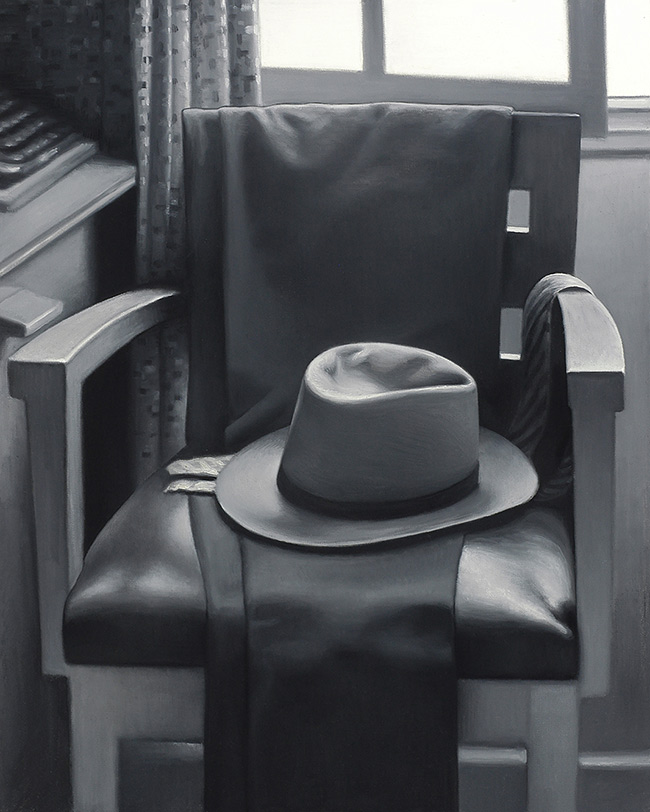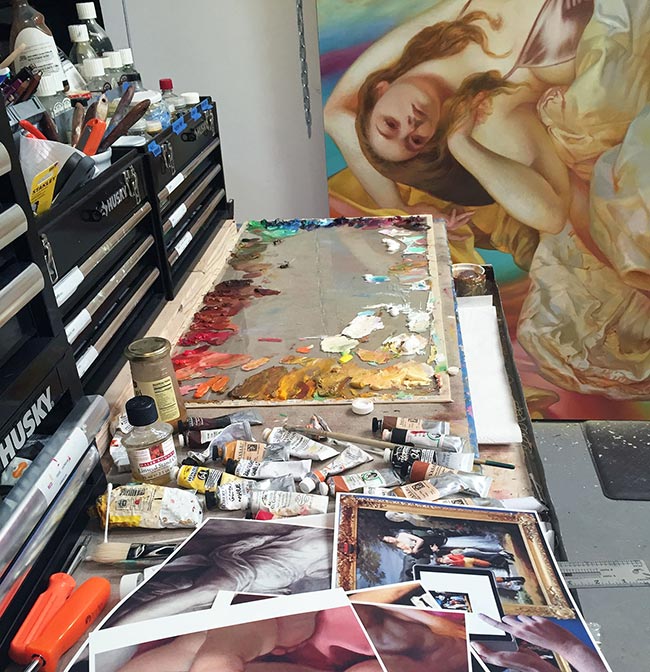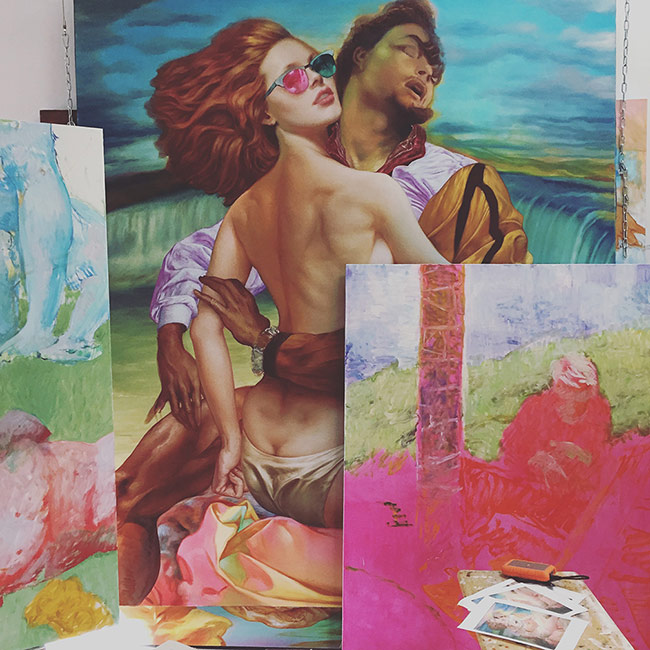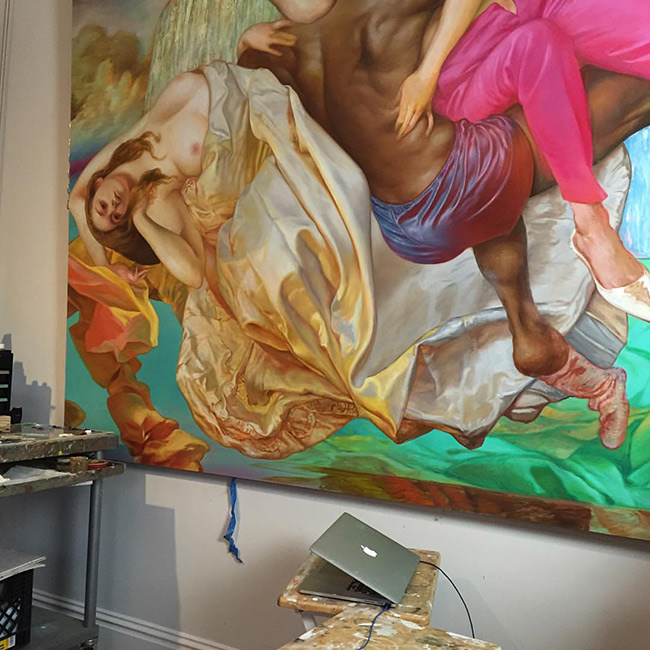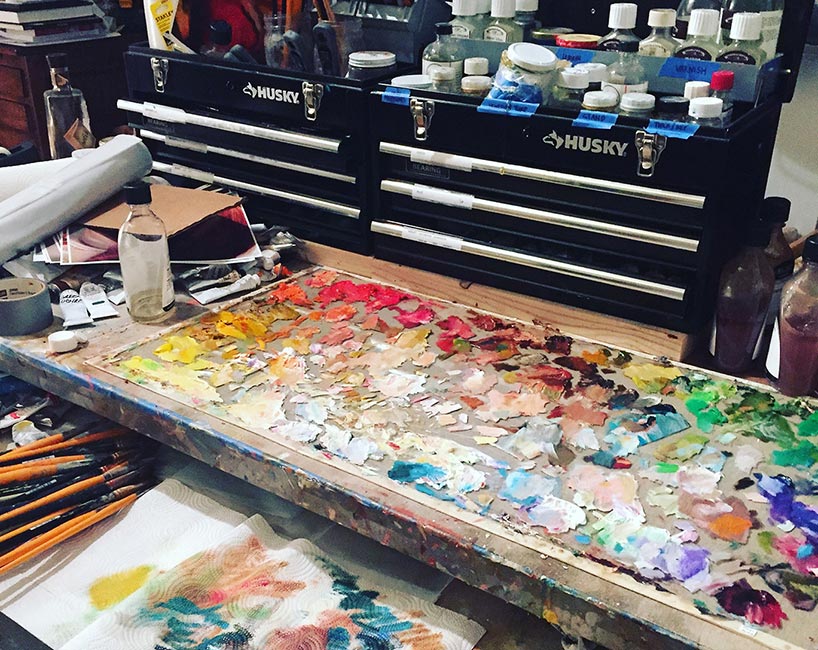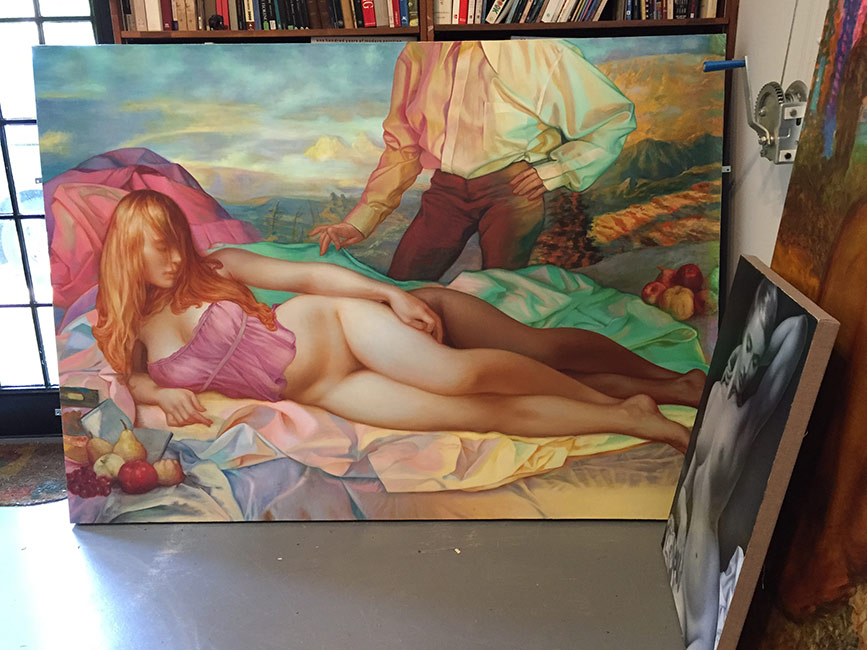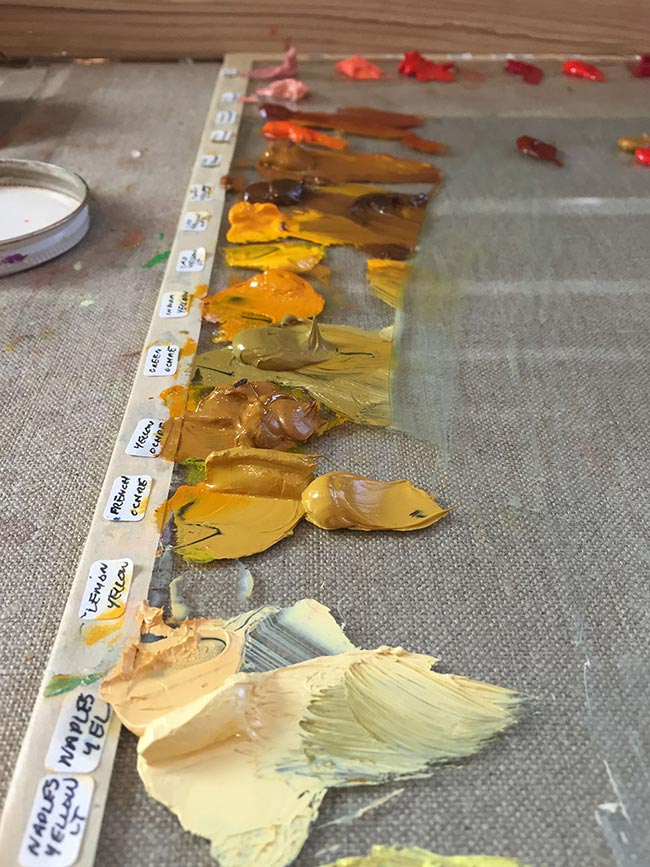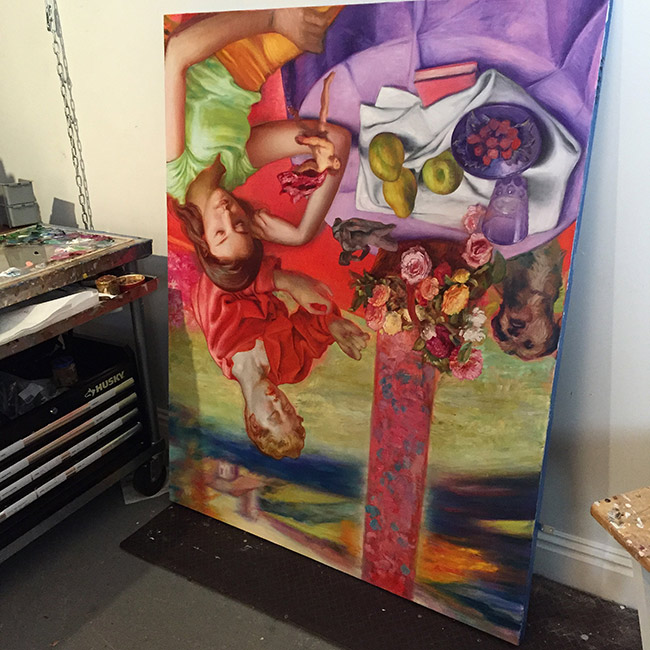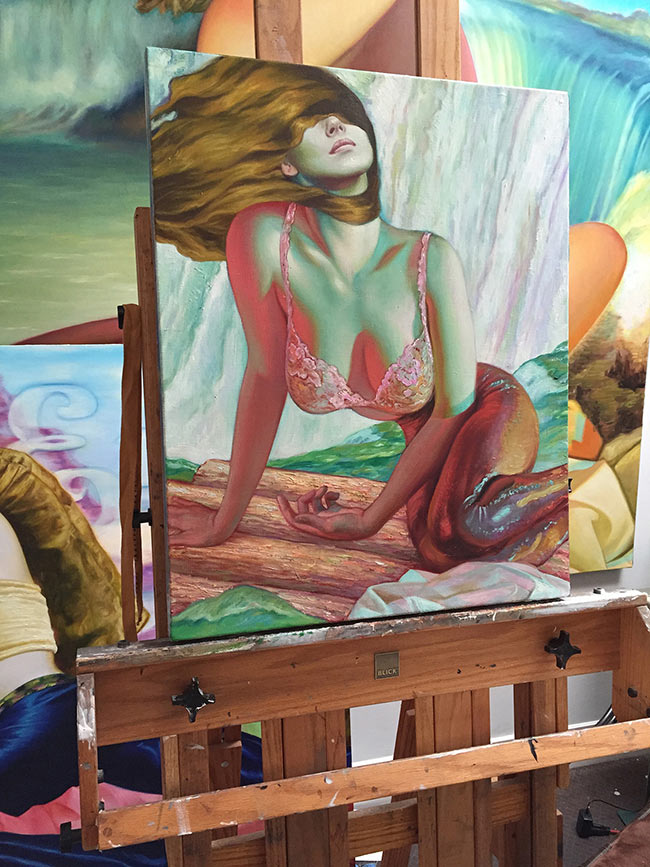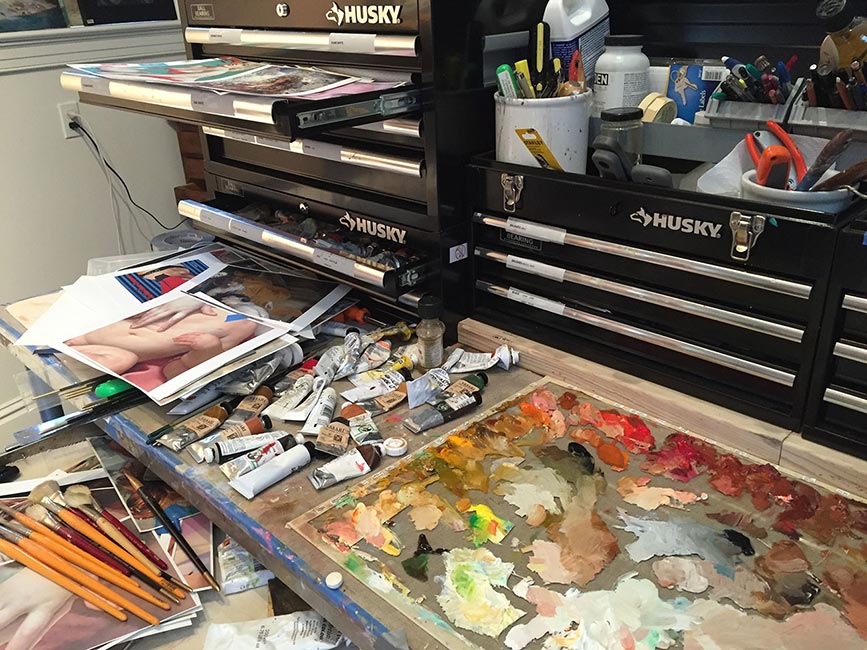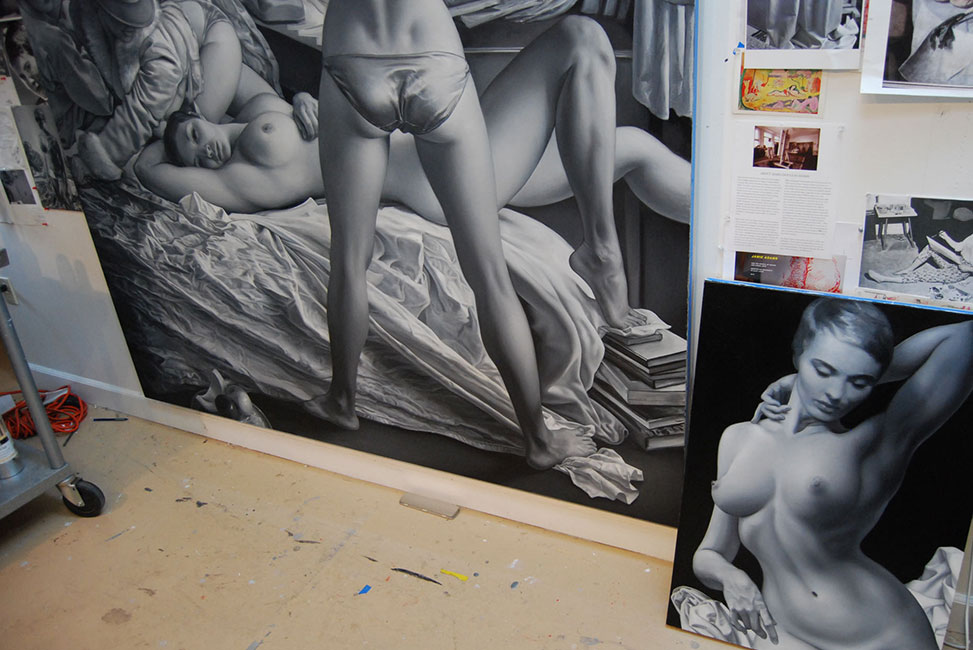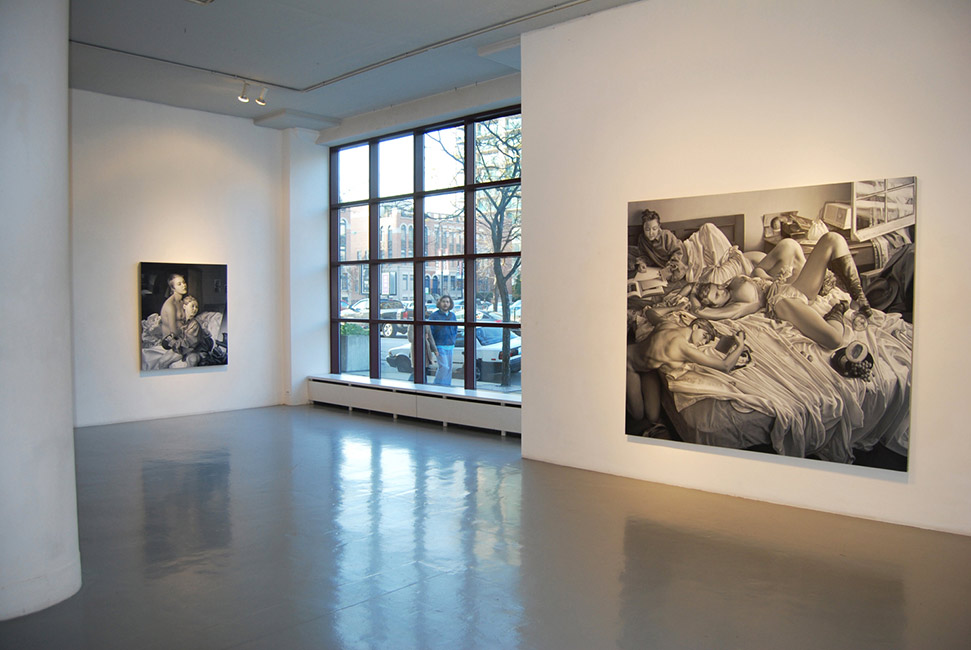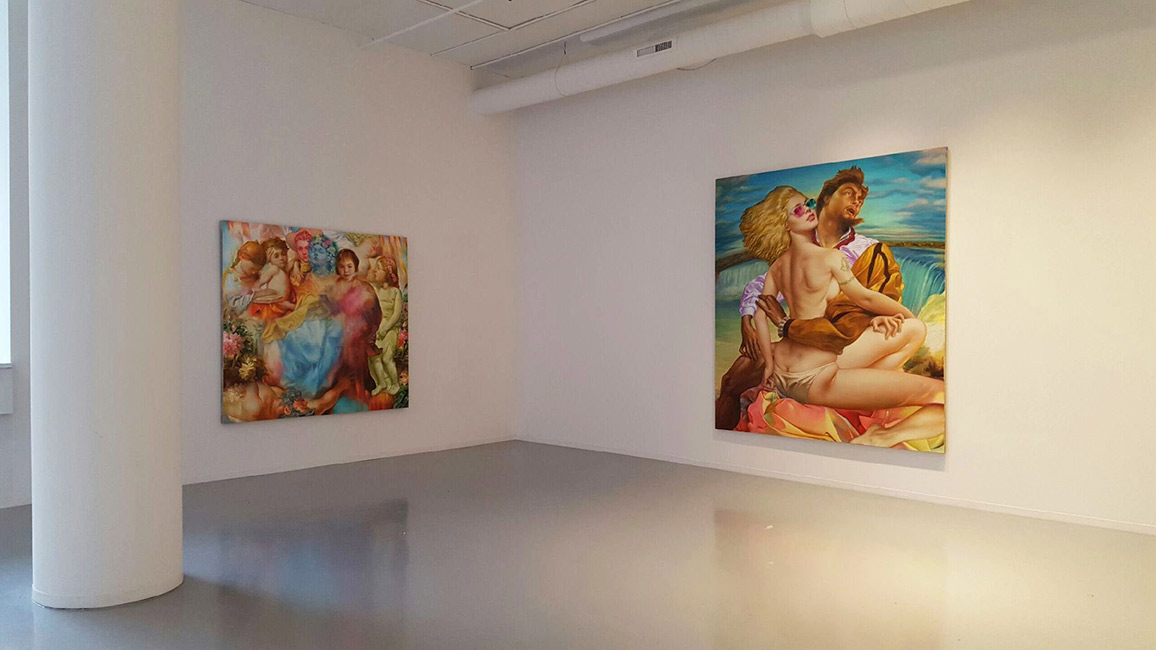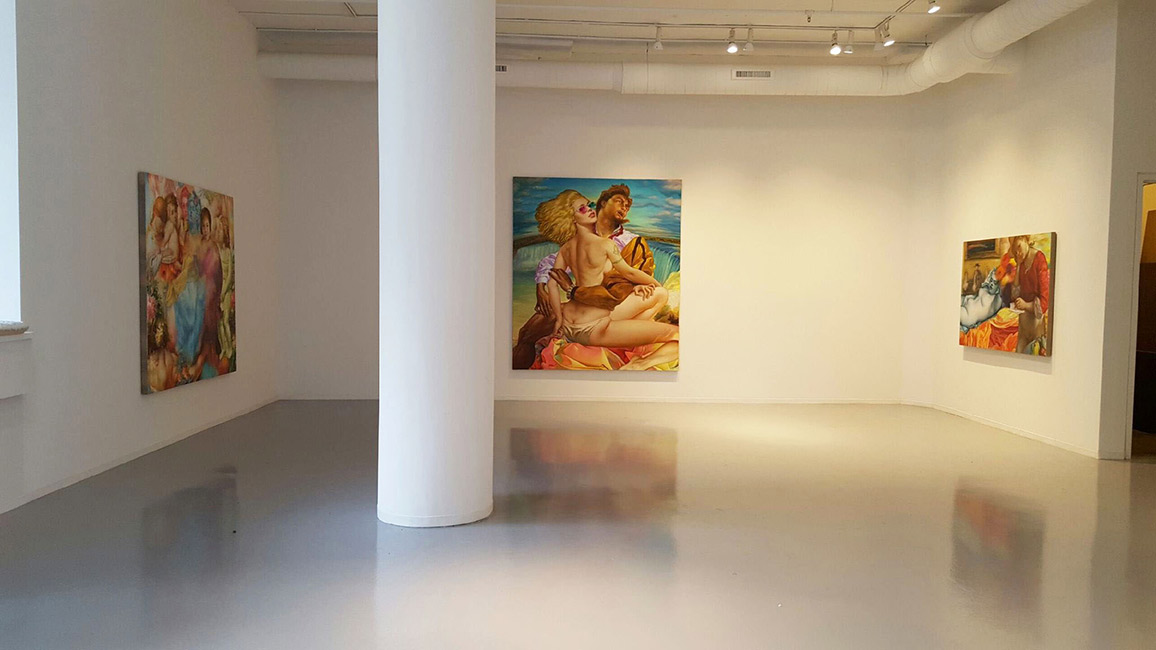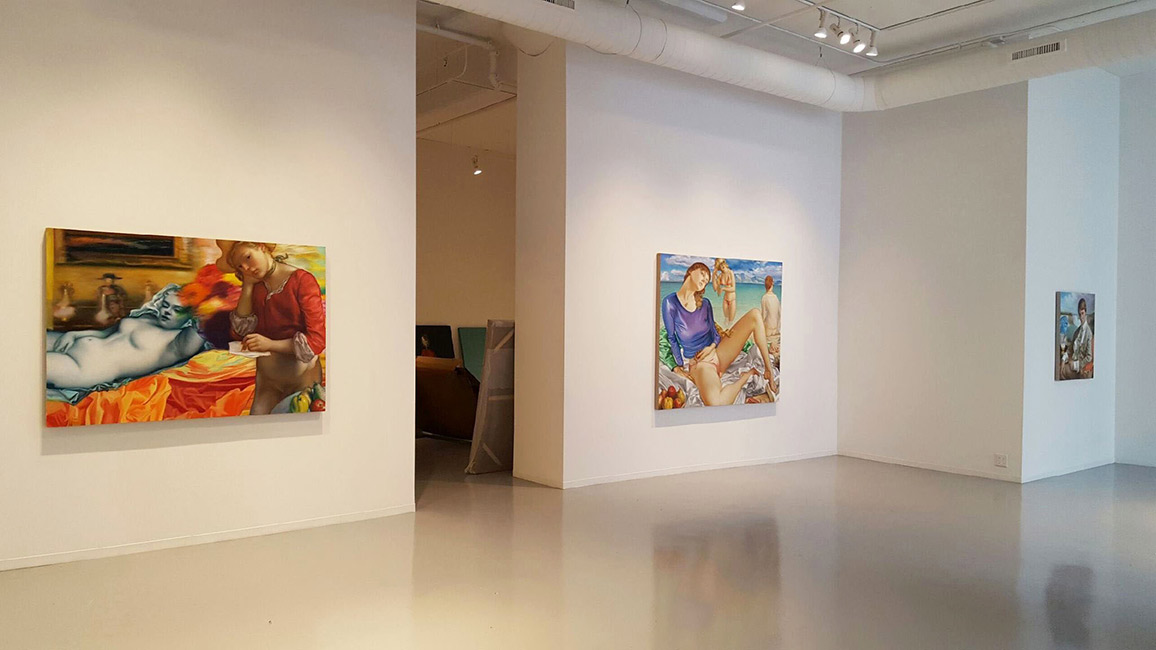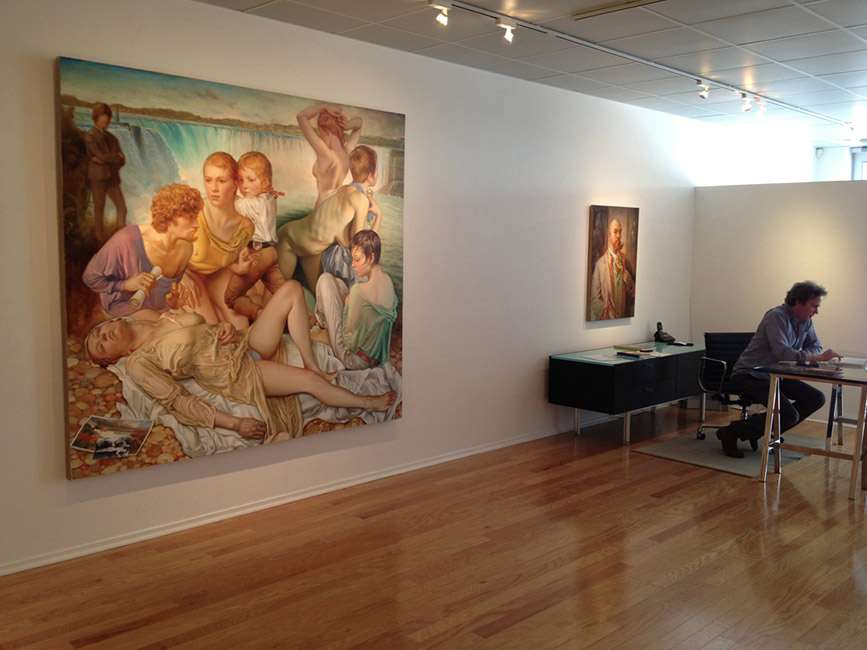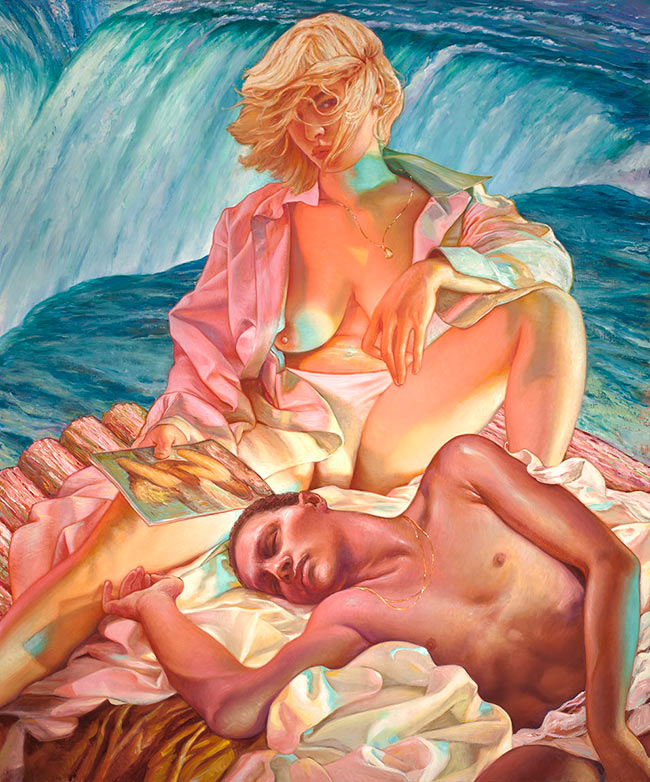By assembling a melange of nostalgically inspired melodrama, artist Jamie Adams beckons to our subconscious, urging it to follow his own into the rabbit hole on a quest for the ever vital artistic holy grail; a glimpse into the human condition. The sprawling tapestry of history, both personal and public, subjective and objective, provides Adams with broad ranging inspiration, and he unashamedly references and borrows from the lexicons of art and film. He combines meaningful tropes, characters and scenarios with his own memories and life events, in turn, constructing imagery which transcends any original content, and which most importantly, offers new perspectives on expansive themes such as identity, the psyche, love and desire. Jamie’s large figurative works cleverly disrupt our conceptions of self, causing disturbances in what we instinctively intuit regarding continuity, and they ask us to probe deeper into our internal complexities on this wild ride called life.
Jamie Adams is an American painter. He was born in 1961 in the suburbs of Pittsburgh, Pennsylvania and currently resides in St. Louis, Missouri with his wife and children. He attended Carnegie Mellon University in Pittsburgh for his understudies, where he obtained a BFA with honors in 1983. In 2000 he earned an MFA from the Pennsylvania Academy of the Fine Arts in Philadelphia. Adams’ work is represented in the permanent public collections of Museu Brasileiro da Escultura (São Paulo, Brazil), Museum of Modern Art Library (New York), MOMA (Wales) and in Los Angeles County Museum of Art Research Library, among others. He is currently working with several galleries: Jonathan LeVine Projects (Jersey City, NJ) David Klein Gallery (Birmingham, MI), Zolla Lieberman Gallery (Chicago), Philip Slein Gallery (St. Louis) Sirona Fine Art (Miami FL) and Lamensch-Douglas Fine Art (Lyon, France).
WOW x WOW was interested to find out more about what motivates this intriguing artist. We sat down with the gracious Mr. Adams to delve into the themes of his artwork and hear more about his inspirations and intentions. Read on!
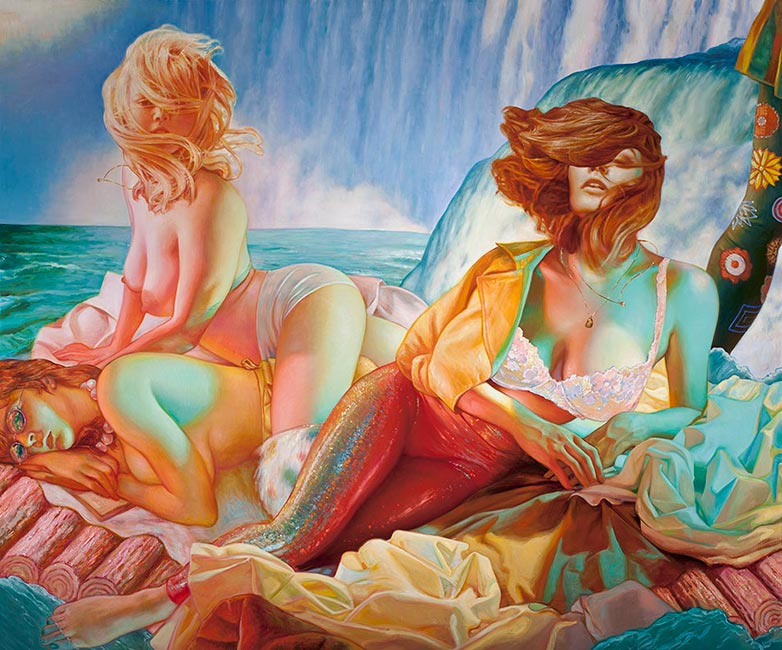
Hi Jamie! Thanks ever so much for freeing up some of your valuable time to have this wee chat with us, we really appreciate it. To start us off, if you would please introduce yourself, touching on anything you feel relevant to the story of Jamie Adams the artist?
Please allow me to introduce myself by way of an assortment of names I have been affectionately called, but sometimes not… Jay, Jayman, Jimmy, Jaime, Jimmer, JimmyD, peaches, patches, derelict, helluva ballplayer, cutey, twit, little petunia, plum plum puddin’ head cabbage, minuchky, mama, yowza, kado, lovey, buddy, bookabba, and most recently, bubba.
I am always the husband, the father, the son, the painter, teacher, the student, sometimes the preacher, penitent though, a performer at heart, a painter, openly questioning, prodding, poking, some tell me the prankster, playing the trickster, pretender, the clown?, I guess a liar loving illusion, a believer, self-absorbed, sports consumer, body-builder, self-deprecating, writing music, dancing, flexing, looking in a mirror, embracing the other, and as a former Stiller fan, not loving nasty Cleveland (and I said this with all due respect).
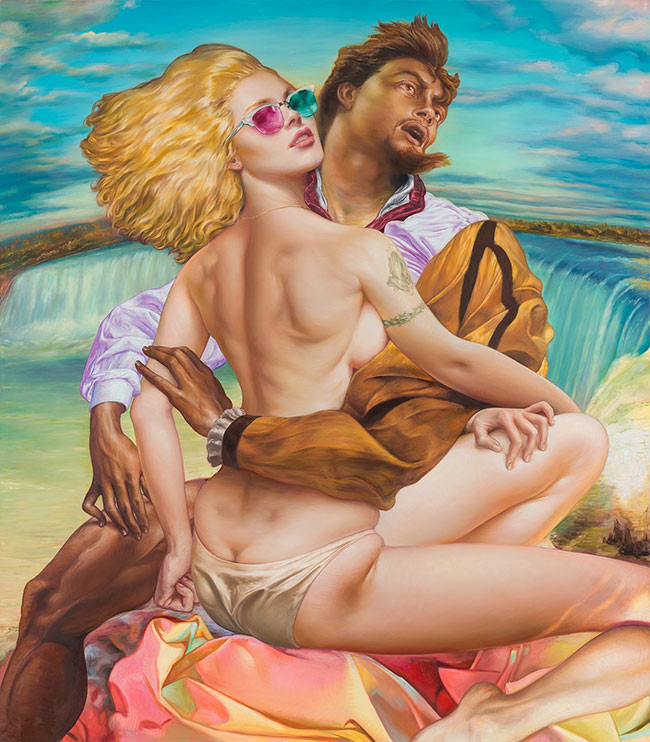
We’re interested to hear about where you’re currently living and what you like about the area? What is the art scene like there and do you feel a part of that community?
My family moved to St. Louis in 2003 when I accepted a faculty position in the School of Art at Washington University. At the time I was asked to manage the Core Program and drawing. Currently I coordinate the painting area and work with graduate students. Over the years I have enjoyed working with a number of venues in town, either with exhibitions or curation. I show with Philip Slein Gallery locally and frequent Chicago where I am represented with Zolla Lieberman.
St. Louis has a thriving art community. St. Louis is quite similar to Pittsburgh where I grew up. In fact when I first arrived here I thought I was having a bad dream, where I had returned to the burgh, but all the names had been changed… It’s been great to see how the artistic community here has shown real courage, dedication with addressing some of the perceived inequities around the region.
The St. Louis Art Museum, Contemporary Art Museum, and the Pulitzer are all significant venues in town, along with the Kemper Art Museum located on WashU’s campus.
One of my favorite places to visit has been SLAM which has an extensive German collection. Most notably is an entire room of 17 paintings dedicated to the work of Max Beckmann (thanks to the local collector Morton May), as he gained a following teaching here at Washington University in the late 40’s.
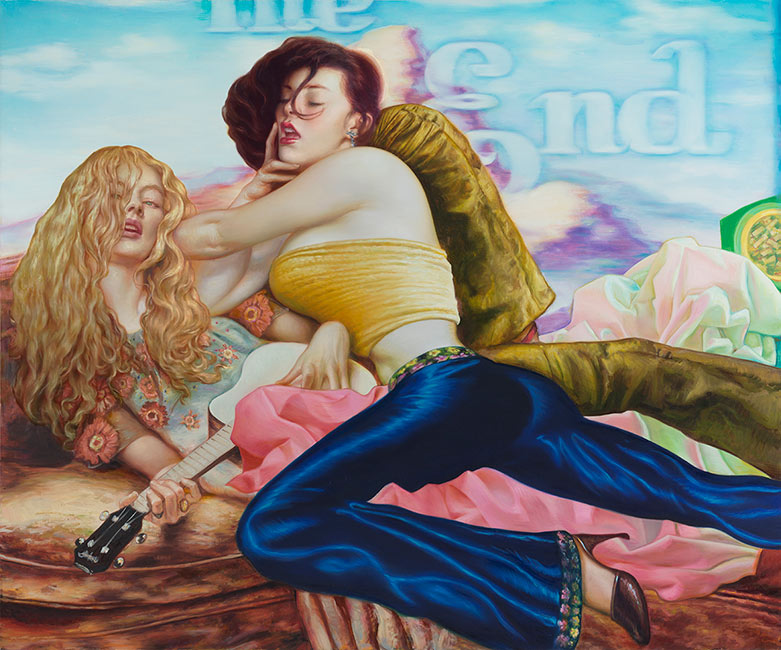
In what ways did your childhood and upbringing affect your relationship with the arts?
I started making drawings before I was walking, writing and reading. So I have had a rather lengthy relationship with making things. Drawing came to me quite naturally, I suppose, almost as if a primal urge. My mother called it my grand inoculator, given my hyperactivity as a child. It helped me focus when I was a child, to entertain myself, but it was also a way to engage the adult world around me. I could make a drawing and count on getting a reaction. My early years were pretty carefree, where I spent time not unlike most other kids – playing with action figures, gallivanting around with sports gear, watching TV like Hanna-Barbera cartoons, sci-fi marionations of Fireball XL5, campy Batman episodes, etc…. and bringing a lot of this stuff into my drawings.
With this predilection to drawing I was invited in middle school to attend a citywide drawing class called Tam O’Shanter held at the Carnegie Museum in downtown Pittsburgh. Andy Warhol, Philip Pearlstein, Raymond Saunders, Mel Bochner, Jonathan Borofsky, Annie Dillard, and Robert Perdziola are all alums. Each week we drew from the museum’s collection and historical artefacts. I still remember particular passages from surveying my favorites – Tintoretto’s underpainting in ‘Allegory of Spring and Summer’, Bougeureau’s opalescent flesh tones in ‘Souvenir’, and Bellows’ luminist color in ‘Anne in White’. I decided to be a painter at that time because I wanted to be a part of this world.
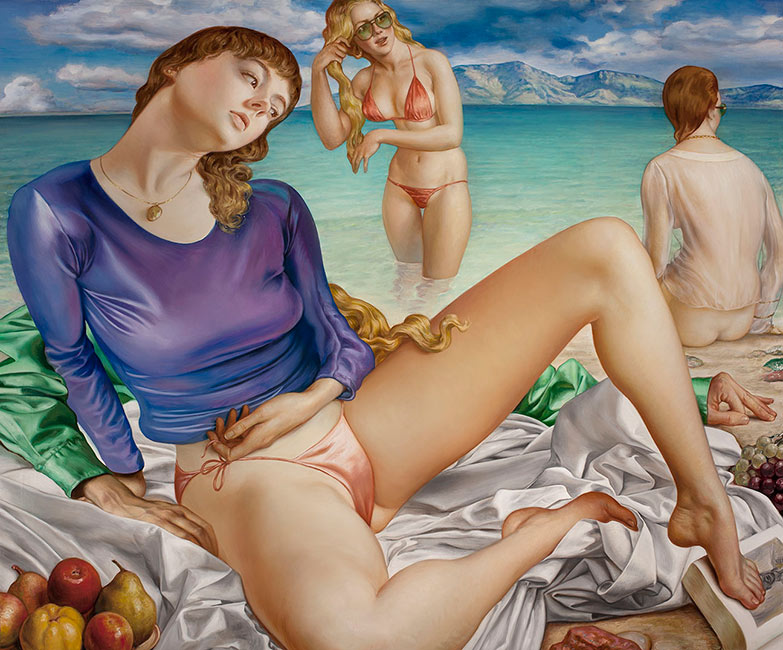
Nostalgia plays a vital role in the creation of your artwork. Please describe your relationship with some of the most dominant influences which inform and influence this aspect of your creative decision making.
I use images reminiscent of cinematic culture of the 1950’s and 60’s, other paintings, photos, or vintage picture books in my work in order to revisit the past and stir things up. I like to think of it as poking around these quirky places I am attracted to, maybe as a kind of Kantian remedy for homesickness. Revisiting old American film noir, melodramas, or self-reflexive Euro American films from the 50’s and 60’s is still a favorite pastime. They remind me of when I was 3 or 4 years old and believed in everything on television. The painter in me is still searching for the ecstatic experience.
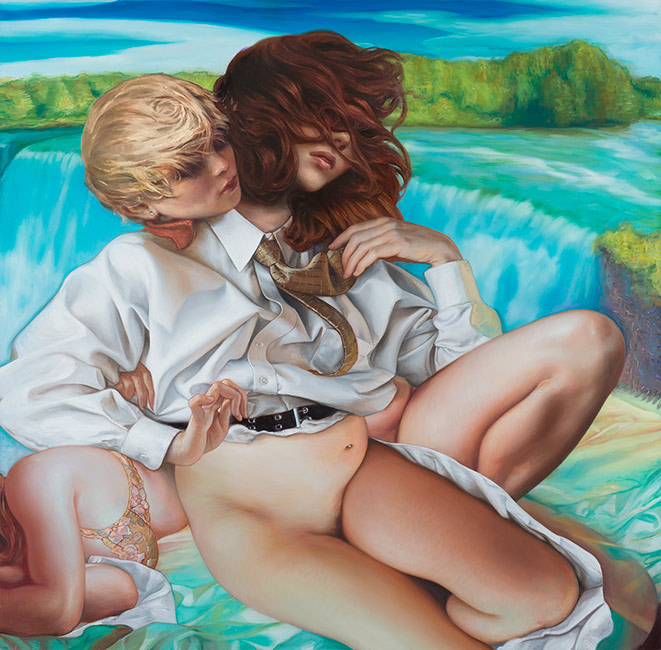
My most recent Niagara series draws from a number of sources, including American Luminist painting and filmic Technicolor. Some of the films I was thinking about at the time were Sirk’s ‘All That Heaven Allows‘, Hathaway’s ‘Niagara’, and Sergio Leone’s ‘Once Upon A Time in the West’. Viewing these 50s melodramas in Technicolor is strange. To this contemporary viewer the color seems paradoxical, this weird mix of post-war affluence and trauma.
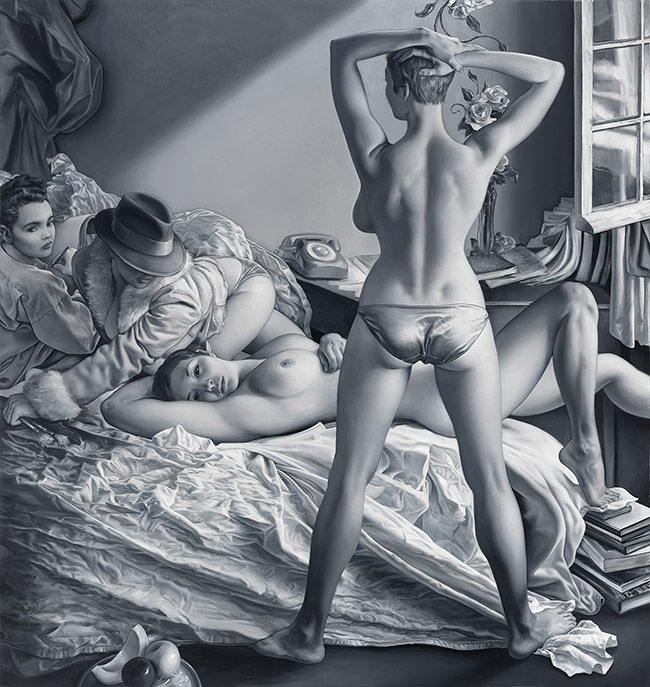
The earlier Jeannie series (2005-2012) was a group of monochromatic paintings based on a black and white film – Jean-Luc Godard’s French New Wave films, Breathless (1960). I was initially drawn to Jean Seberg’s character in the film, and the soft ambient light in her bedroom apartment and how it affected the folds in Jean Belmondo’s coat. I made a number of these over the course of six years, black and white grisaille paintings where the environment was focused on a specific place – a Parisian bedroom apartment in the film. At the time I just wanted to belong to this filmic space; to settle down, set up shop and make something. As grisaille paintings they appeared ‘unfinished’, impotent – implicitly signaling painting’s own cultural malady, or condition of belatedness? As I think about it, the impulse to fit into the cinematic space probably emanates from my own experiences as a teenager performing on stage, in musicals, being obsessed (briefly) with disco dancing. It certainly has given me some perspective regarding the theatrics and mannerisms present in much of European painting.
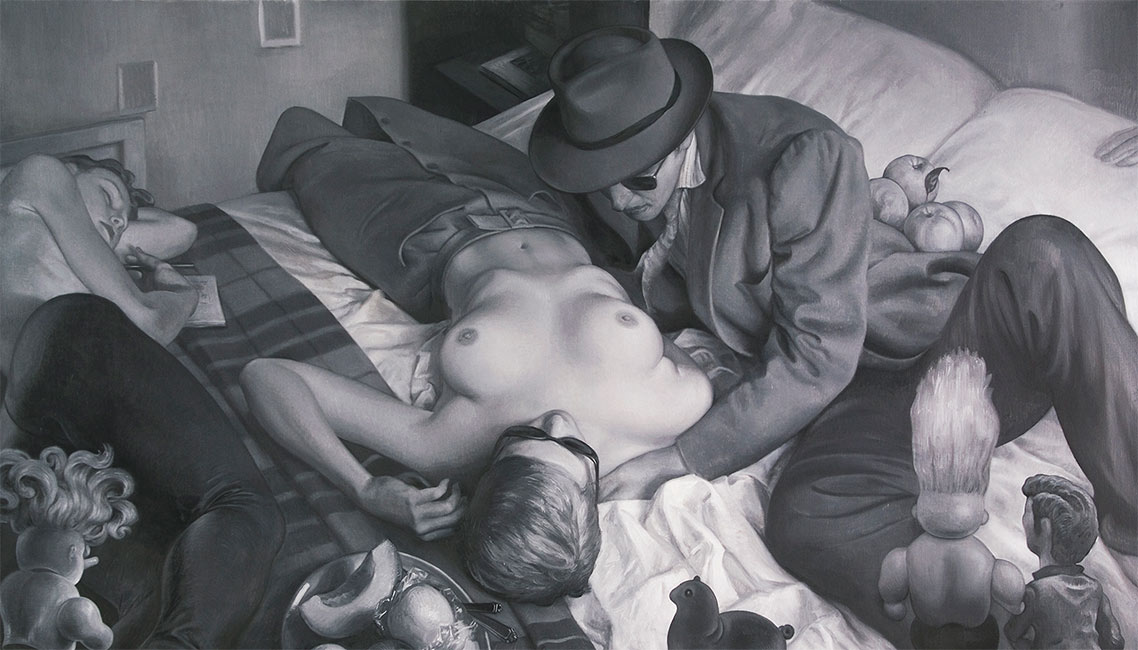
Gender as a means of identity seems to be a subject you contemplate through your painting, and often we encounter protagonists portraying ambiguous gender roles. What is it that fascinates you the most about identity and gender, and what are your thoughts about the gradual breaking down of the stereotypical attitudes towards gender within current popular culture?
The characters in my work come about in so many different ways. It would be a mistake to think that because the paintings ultimately look rather concretized and solid that they are largely pre-planned. In reality that’s rarely the case. Most often I simply begin directly on the canvas. Character will often go through a series of alterations throughout the painting process, much like interviewing actors. And the auditions end only when I come to something that resonates. I think of them as psychic portraits, representing life as an accumulation of experience, not a fixed, perfectly stabilized condition. Within the old man is still the boy. I want to capture that kind of complexity in my painted characters. It’s like looking in the mirror and seeing both my parents simultaneously in my own physiognomy. It’s that kind of visual conundrum that I’m am interested in. The ambiguity leads me to explore the complexities of identity.
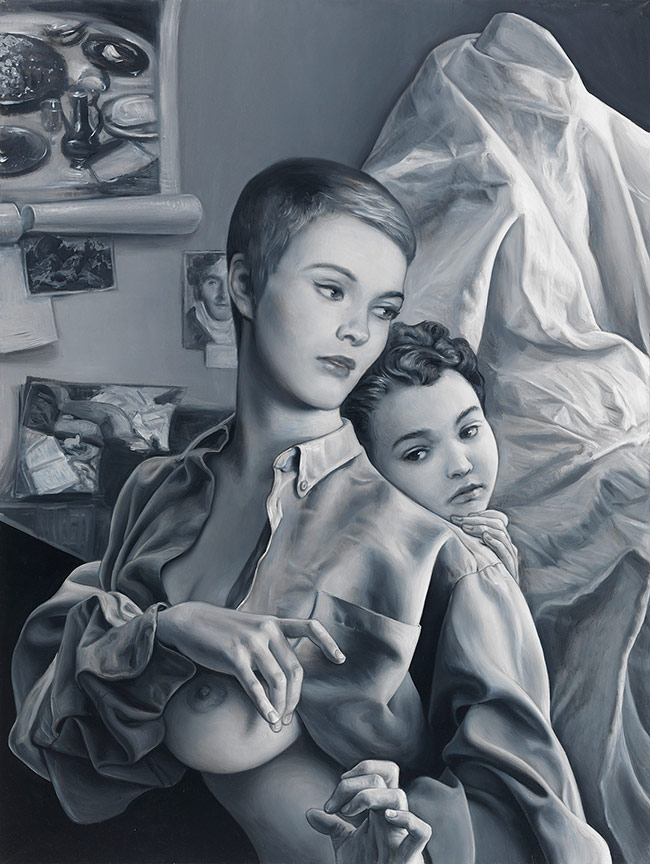
Interestingly my wife tells me that she recognizes herself in the Jeannie character. I can see it now, although that is not what I imagined at first. In fact, I can see the both of us, as if the persona of Jeannie created for these paintings is our own offspring. As a result I have come to understand how it’s our relationship that actually fuels the paintings’ primary features – their meaning to be found in the subliminal, sexualized gesture, delicate paint handling, the caressing of figural forms into subtle volumes, the modeling of ambient light as it gradates through the surfaces of things. Meaning located in the touch. My relationship to this work has deepened over time. And it makes me realize once again that there is often present a kind of subterranean narrative that I will only come to understand well after the work has been completed, if I’m lucky.
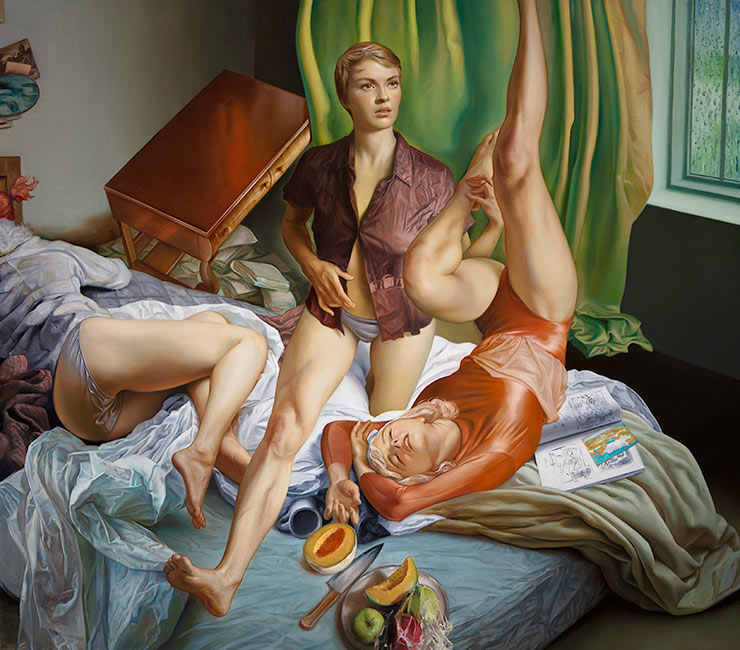
The occurrences and scenarios that appear in your imagery are suggestive of anomalies arising in time and space. Sometimes achieved through your use of different painting techniques within the one image, other times by way of awkwardly positioned objects or distorted figures, on other occasions this may be suggested by your use of colour. Please tell us about some your inspirations regarding these ‘disturbances’ in the unfolding narratives.
I think the idea of montage that we get from film has a lot to do with it. But it’s not simply about the juxtaposition of images to create narrative. The painter utilizes his own set of tricks. On the one hand I want to create believable illusions. But I also want the painting to function like a film, as an extended visual experience. So I am interested in dismantling/reassembling representation, often using tropes of the screen – such as range of focus, or projection, or anamorphism. This is the magic of painting. One example: Caravaggio shows us in his ‘The Taking of Christ’ (1602) chaotic movement via visual ambiguities and implied sequencing three hundred years before Muybridge’s photographic experiments. Edward Hopper’s use of these kinds of devices is more directly related to film in ‘Western Motel’.
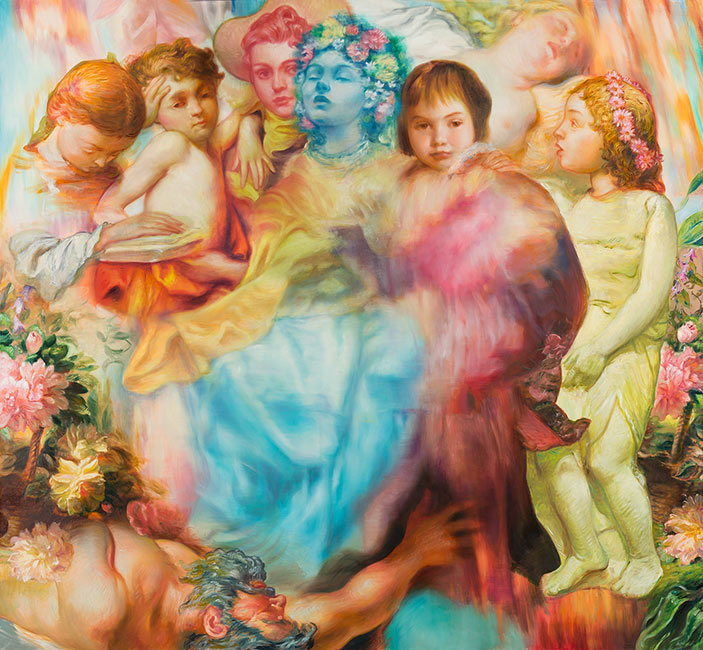
Many of your paintings contain inspirations derived from your love of art history and cinema. Could you give us a little insight into the thinking behind your incorporation of these elements? Do you feel that it’s important for a viewer of your works to have a certain amount of knowledge in these areas in order to be able to connect with your works? What are your thoughts about the dialogue and conversation cycle which is created between the artist and viewer?
I think a lot of it is a function of having looked at so many things over time. At this point there’s a strange way that these enculturated images are in my consciousness. And now the ubiquitousness of the smartphone photo seems to have even more of an impact. Susan Sontag talked about how the plethora of photographic information has an incalculable effect on our ethical sensibility. Time to turn off the phone?
The other day my students and I spent considerable time at the school’s Kemper museum in front of one of Philip Guston’s large allegorical paintings ‘If This Be Not I’ (1945). Great paintings demand an extended view… We talked about his artistic appropriations – de Chirico backdrop, Beckmann-like characters, the foreground a mixing of della Francesca/Picassoan. Having an awareness of these references can be quite useful but without it, Guston’s new form communicates powerfully on its own. This particular piece is said to be his opus from his early period. It took a year to complete. He wanted to put everything he knew into it, as if he it was to be his last painting.
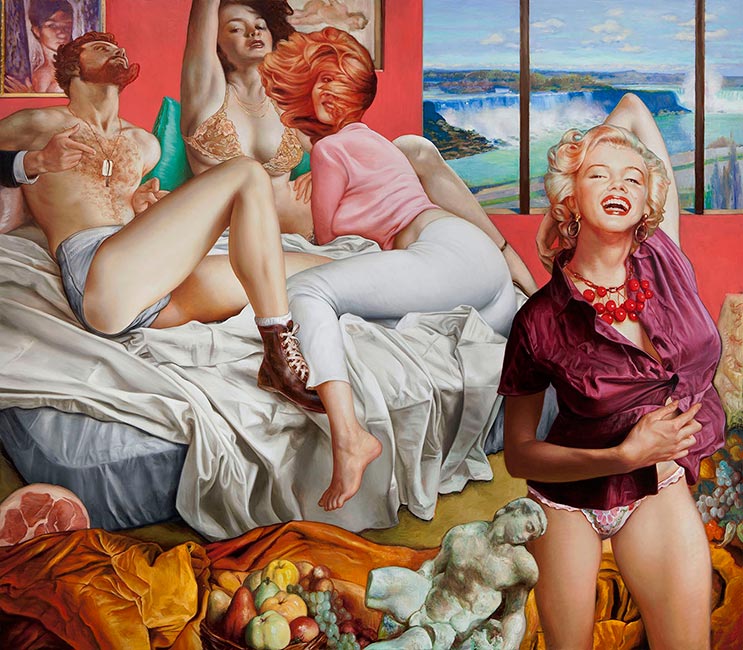
You have explored the power of colour from all angles over years, having focused on monochrome works with the grisaille technique employed in your Jeannie series and more recently with your often vividly coloured Niagara series. What differences have your experienced with these varying approaches to colour, and what impact has your chosen colour palette had on the direction of your imagery?
The color shifts have to do with how I give myself projects. I liken it to a director building an aesthetic for a film. Each color strategy creates its own demands. The monochrome Jeannie paintings were obviously based on Breathless as a black and white film. It was important to develop a tonal strategy where color could be felt. The figures became progressively marmoreal, hard edged and precise.
My most recent Niagara series draws from a number of sources, including American Luminist painting and filmic Technicolor. Some of the films I was thinking about at the time were Sirk’s All That Heaven Allows, Hathaway’s Niagara, and Sergio Leone’s Once Upon A Time in the West. As I thought about returning to color, I was drawn to the Technicolor used in many of the 50’s melodramas. The saturated color has a strange effect on the filmic image. Color functions as a kind of agitator. From a contemporary perspective Technicolor’s overly saturated color in those films seems to embody the anxieties of post-war trauma, and society’s striving for conformity, prosperity, peace. I want that kind of agitation in my work, something having the effect of the digital screen, psychodalia.
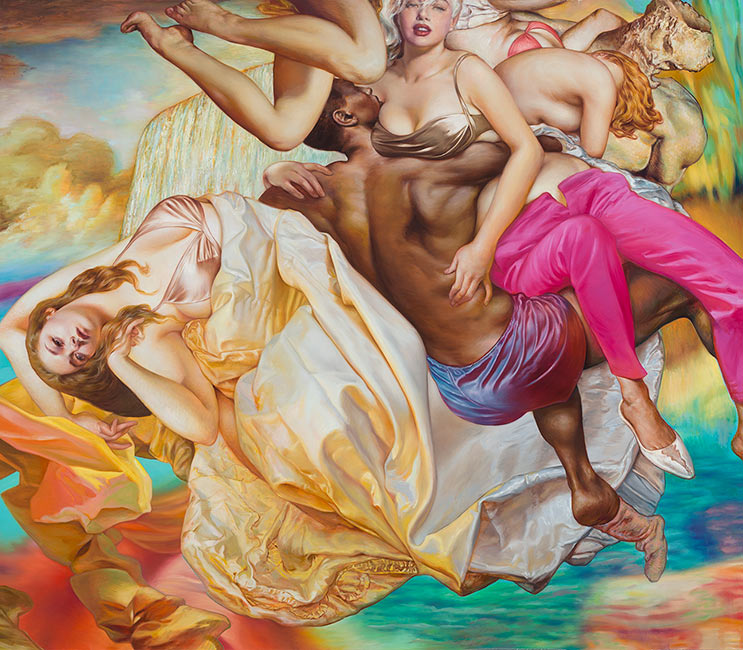
There is a distinct blurring of the divisions between high and low culture within your subject matter. How do you think about these divisions when you’re constructing your paintings?
I enjoy the dissonance between high and low culture. For me it’s also about seeing along a timeline – about conflating the chasm between action figures from my childhood like Johnny West/GI-Joe and today’s such as Michelangelo’s Florentine Pietà. I place all of these on the same playing field. Social media, online stores and auction houses make it possible to reacquaint oneself to the past.
What do you feel is the most essential factor an artist must be open to, regarding the evolution of their practice? Having had a lengthy and successful career so far, how have you seen your own work evolve over time?
My advice for the artist is a lesson learned from others: draw from the past; embrace the present, face the future.
The evolution of my work is difficult for me to see. Maybe because I am so inside of it. It’s like looking in the mirror every day. You see the same thing over and over. Any change is negligible. Then one day you look at yourself and realize you are completely different, maybe even unrecognizable. So I make up the difference imagining, constructing an image I can live with, this idyllic projection. I don’t know if that really answers the question, but that’s one way I can describe the evolution of my work.
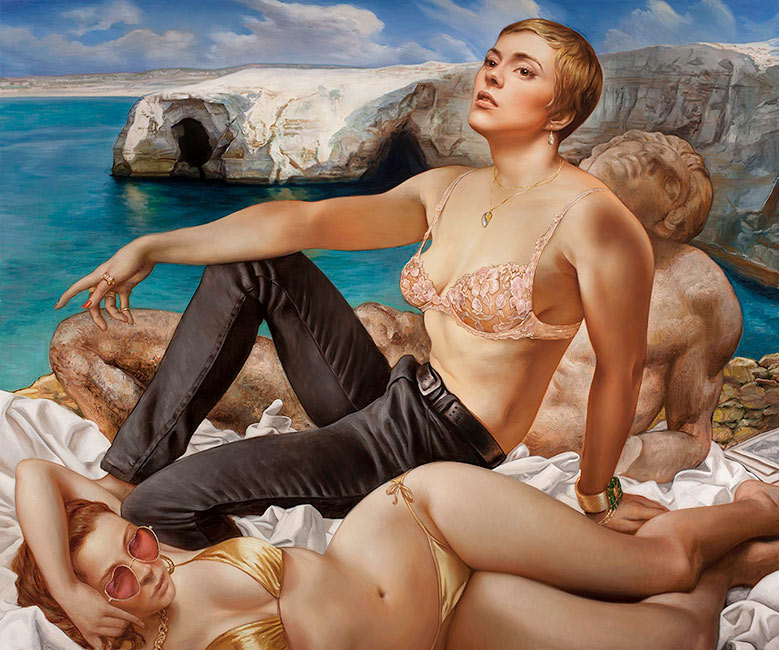
What are your opinions about beauty in reference to man-made artefacts? Is beauty something that you search for in art and is it something you consider when producing your own work?
Beauty is not really something I think about when I am producing. Things that are perfect are not very interesting. So I develop form and image on my own terms. How it is defined is up to someone else. I do know that it’s not necessarily about appearances, or a visual affect. Ultimately I am suspicious of surfaces, where everything moves in one direction, fits into place, obeys certain cultural conventions or rules. If I look for anything it’s some kind of disturbance or complication. This to me is truth. I think of paintings like Delacroix’s ‘Death of Sardanapalus’ where the artist fills the scene with vignettes of beautiful objects, but the overriding force of the picture is one of turbulence, a chaotic scene of terror and immolation. Even his oversized figures flail with rhythmic twisting and torqueing much like Michelangelo’s Figura serpentinata. I want more of this kind of dualism in my work, the paradoxical situation where you are feeling two emotions simultaneously. It’s where you’re attracted by the allure of beauty, but repelled by something you can’t quite articulate. A conflict I suppose between harmony, lust, pleasure (Eros) and frustration, even destruction (Thanatos). Isn’t this the human condition? – In the dialect of psychoanalysis, something between desire and drive?
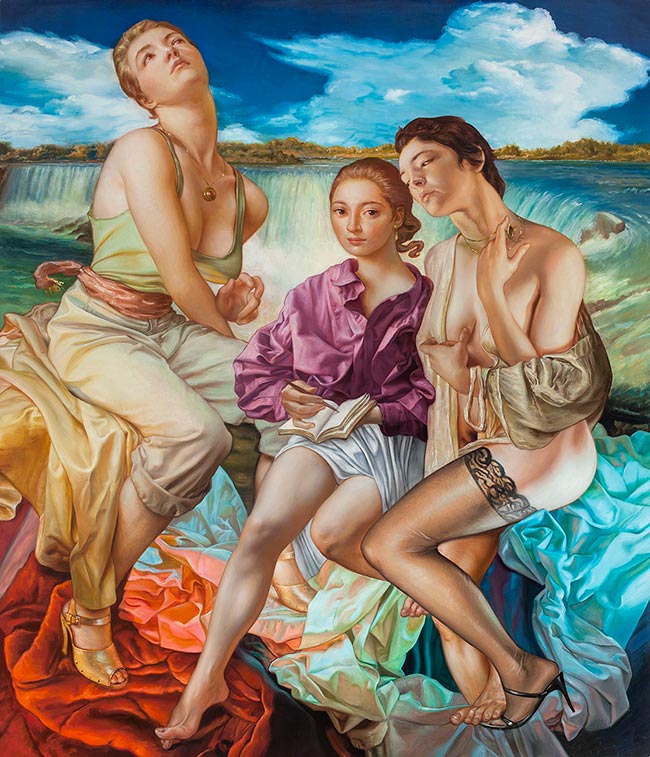
Why do you think that painting is still managing to stay relevant, irrespective of many critics and academicians proclaiming its death over the years?
This is all commentary off the real playing field. Painters are the ones who determine the life and death of painting. For me its maybe a little of both. When I walk into the studio each day I feel compelled to breathe new life into something. It’s the most frightening and exhilarating experience. It’s not something one talks about. It’s something that is experienced in front of an empty canvas, creating something out of nothing. When I hear this question I think of how long it’s been since the French painter Paul Delaroche first made the statement that painting was dead after encountering a daguerreotype. Nearly 200 years? But Delaroche kept painting for another twenty years. For the rest of his life. And since Delaroche’s own death artists have treated painting like anything from a passionate lover to a crash-test dummy. And for those who think paint to be flat-line, but still wish to paint, are happy (read this somewhere?) to parade around its corpse. Obviously contemporary painting, in all of its forms, doesn’t occupy its place of primacy within popular culture as it once did. Especially now, as culture continues to move toward visual ephemera, digitalization, and fabrication, etc… But it serves me as a marker for desire and loss, as it has substance, a surface, leaves a trace of the hand, as it requires a great deal of attention to craft.
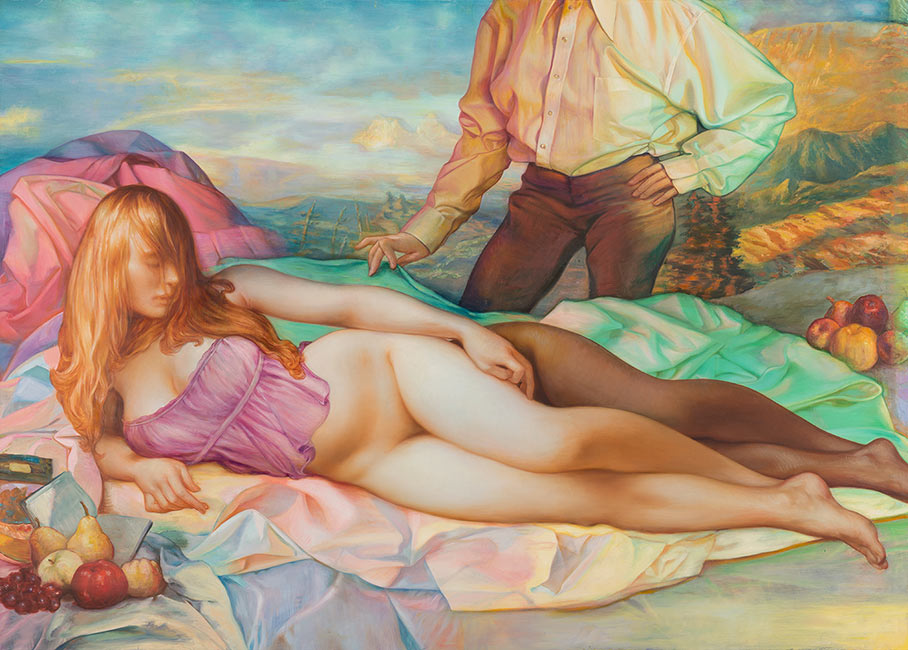
In order to get a better understanding of the personality of an artist, it can help to get a peek behind the curtain. Would you be willing to share a story from your own life, possibly one whose memory you find yourself returning to for inspiration, or maybe just a tale about a hardship you’ve overcome which has helped define the person and therefore artist that you are now?
One of our daughters was severely burned as a child. This experience, as one can imagine, was devastating for the whole family at the time. The story ends well. She has since recovered and lives a wholly productive life. So much of life’s experiences enter into the work, but the memory of incident has stayed with me. I am sure it is one of the reasons why the characters in my work move as if in a state of turmoil, in a state of flux, transience, transformation.
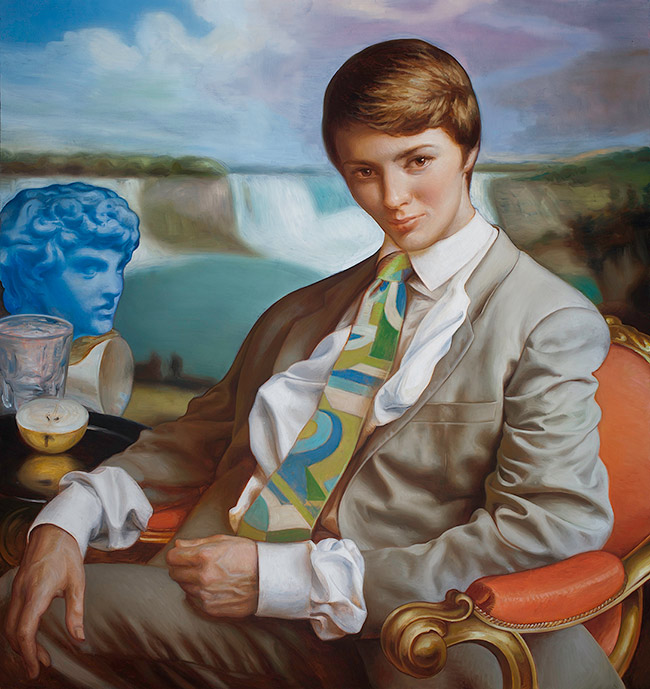
If you could own one piece of art from any of the world’s collections what would it be and why?
I wouldn’t mind living with Gericault’s ‘Raft of the Medusa’ (1818–1819) from the Louvre. It’s visually overwhelming, enigmatic. Depending on the viewer’s disposition it’s a depiction of either hope or utter despair all at once. For its time, it was initially rejected, probably viewed as a subversive, contemporary version of Michelangelo’s ‘The Last Judgment’, with its ‘terribilità’, writhing bodies. I read somewhere Géricault’s comment, “Michelangelo sent shivers up my spine, these lost souls destroying each other inevitably conjure up the tragic grandeur of the Sistine Chapel.” Another painting, actually located here in St. Louis, would be Max Beckmann’s own maritime tragedy ‘The Sinking of the Titanic’ (1912-13). And if there’s a blue light special, still another version would be Philip Guston’s ‘The Pit’.
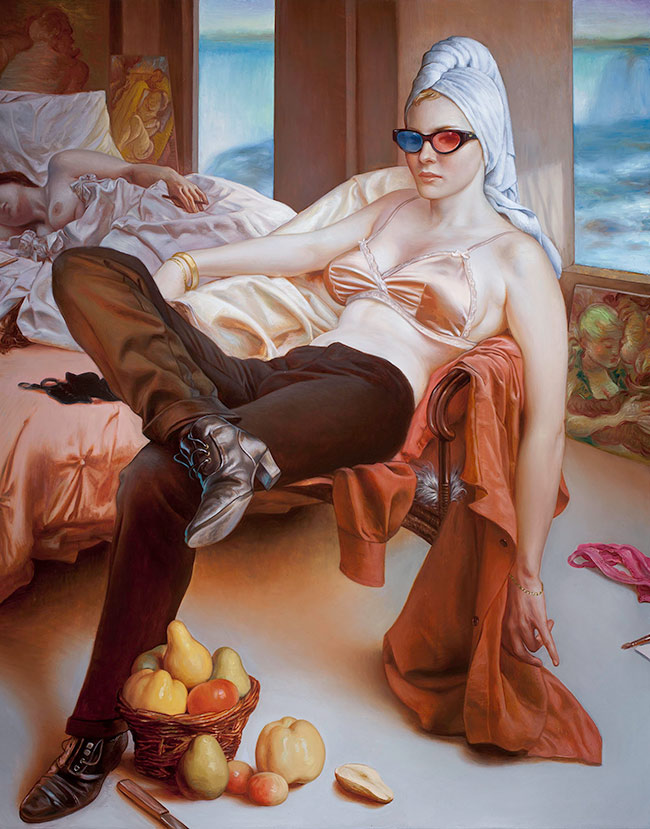
What’s next for Jamie Adams?
For the last few months I have been making drawings. I’ve just completed quite a few years of developing the Niagara paintings and I feel like I have come to my own precipice. So I am making some figurative maquettes and small environments, exploring new materials. Among other things I am developing images I am calling Blondie Bubba works. The title comes from nicknames for my father as a boy and now as a grandfather. A few paintings completed but not shown, are ‘Blondie Bubba’ on a Red Porch’ and ‘Blondie Bubba Drawing in a Field’. They’re fictional versions of my father’s life, based on my own dreams where I’ve encountered him and my own daughters together as children.
